The Tucson Chronicles: Volume 1, Number 1: Page 6 Buffalo Bill Cody's Gold Mine
These pages of Tucson Chronicles features stories from the new book, "Treasures of the Santa Catalina Mountains," now available online at amazon.com. and local Tucson businesses. Tungsten For Edison’s Bulbs; Iron Door Mine SearchThe rumor that Buffalo Bill had a gold mine in the Santa Catalina’s near Oracle is true. In the early 1900s, William “Buffalo Bill” Cody had mining interests in Campo Bonito, located outside of Oracle on the northern edges of the Catalinas. He also owned the largest gold mine on the mountain- the Southern Belle. When Cody went to explore the property, he said he walked one hundred and fifty miles in four days and was impressed by the prospects. The mines at Campo Bonito contained gold, silver, and tungsten that yielded about $30 a ton. Tungsten was an ore used in hard- ening of steel. Thomas Edison needed tungsten from Campo Bonito for his light bulb filaments. With new bulbs on the market the demand for tungsten began to increase. The plant had a capacity to process one hundred tons a day. “In one part of the estate the ores run to gold, copper and silver, in another to lead, silver and gold, and in another section to gold, lead and tungsten,” Cody said. That could be a profit of $2,000 a day, according to sources in the daily newspaper. Some historians have discredited Cody’s investments in the Santa Catalinas. Between $300,000-500,000 was supposedly lost and left a black mark on Cody’s legend. In fact, Cody sold 361,000 shares from $1 to $12 a share. Cody, and his friend William Neal– owner of Oracle’s Mountain View Hotel– searched for the Iron Door Mine several times when Cody stayed in Oracle. During Cody’s winter visits to the camp, he would por- tray Santa Claus for the children of Oracle. After his last performance on Christmas Day in 1916, he caught a cold that proved fatal. When Cody died, he left behind a legacy in Arizona that is covered in detail in the book “Treasures of the Santa Catalina Mountains,” beginning on page 321. Oracle’s Old hatThe town of Oracle was originally a camp for the miners who worked nearby during the late 1870s. New mineral discoveries brought many enterprising miners to the hills tucked into the northern edge of the Santa Catalina Mountains called the Old Hat Mining District. Shortly after his arrival to the U.S., Albert Weldon staked a claim for the Oracle mine in 1877. He named it after the ship that brought him around Cape Horn to the U.S. In May, 1878, James Lee and Charles Franklin made a discovery of free gold while Lee was building a road to reach the pine timber in the mountains. The ore is “full of free gold and is reported to be very plentiful– judged by the surface prospects,” according to newspaper reports. On Christmas Day 1878, Weldon, and his partner Alexander McKay, located some ore and made a claim to the Christmas gold mine. Then one week later, on New Year’s Day 1879, they staked a claim for the New Years mine, just north of the Christ- mas. Both mines were located within the present day town of Oracle. Weldon began a bush mining camp, called Weldon’s Camp that had an abundant supply of timber and water available. A spring provided water to Weldon’s Grotto to bathe the dirty miners. The nearby town and smelter of San Manuel is on the same ore-body– the Kalamazo– and is the end result of the legend. After four decades of production, the San Manuel mine was the largest UNDERGROUND gold producing mine in the United States. Cody Stone– The Catalina’s LegacyThe same minerals mined over 100 years ago in the Santa Catalinas are still found in those mountains. One type, quartz embedded with silver and gold, is called Cody Stone, named after Buffalo Bill Cody. Samples of Cody Stone are on display in fourteen mu- seums worldwide, including the Mining Hall of Fame and the Gem Institute of America. For five years during the last half of the 1990s, an educational exhibit at the Tucson Gem and Mineral Show highlighted the history of this epic gold legend. Although each stone has to be graded individually, it generally has an established value at $5 per carat for silver content and $25 per carat for gold content, according to William “Flint” Carter who mines the stones from an undisclosed location. Locally, samples of Cody Stone are on exhibit, along with artifacts from the Cat- alinas, at the Oracle Inn Steak House in Oracle. Southern Belle Gold MineOver “one million dollars in gold” was extracted from the Southern Belle Mine, southwest of Oracle by 1908. Visible gold could be found through the whole ledge. At one time, the mine was owned by “Buffalo Bill” Cody. Today the Southern Belle is an abandoned mine on private property. It is not necessary for a property owner to file a claim to mine. The greatest gold mine in the Catalinas can end up in a backyard, but glory cannot.
|
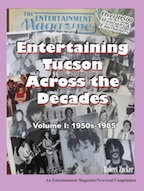 |
Entertaining Tucson Across the Decades | 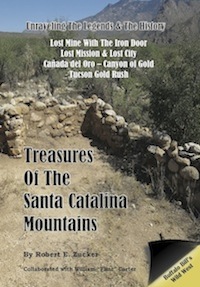 |
Treasures of the Catalinas |
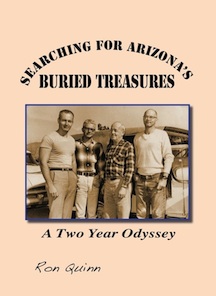 |
Searching for Arizona's Buried Treasures | 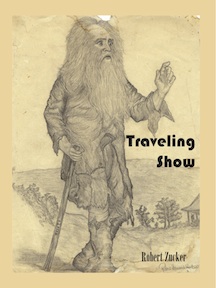
|
Traveling Show |
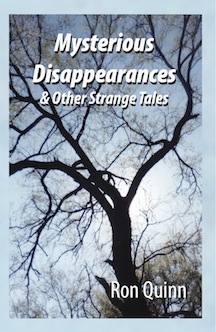 |
Mysterious Disappearances |
Tucson Chronicles will soon feature upcoming print and web editions of "Entertaining Tucson Across the Decades," a recent book also by author Robert Zucker with hundreds of articles and interviews from the 1980s published in the Entertainment Magazine and Newsreal newspapers. The first edition covers the 1950s through 1985.